The Past is a Copy of a Copy
My interdisciplinary practice interrogates the history of displacement in the Americas, starting with Indigenous dispossession and genocide to current issues around gentrification and homelessness. At its root, however, it is a critical reflection on the commodification of land as private property and the issues that arise out of this. I articulate these subjects through printmaking, installation, and sculpture, to outline the contested use of space and the ways that social and political policies have shaped our contemporary urban environment. This exhibition is composed of three print-based installations which utilize different approaches to documenting the political, socio-economic, and geographic landscape of the Los Angeles Basin. In all three interventions, elements used rely on the use of a contested historical imaginary, and invite the viewer to reflect on the past and its relationship to the present through archival sources, historical iconography, and specimens of historical significance.





Artist Statement
In the installation titled, “Geometries of Displacement,” I use digitally-reproduced archival maps of Los Angeles County dating from 1769 to the contemporary moment, which represent different historical periods in the development of the region. Embroidery is used to emphasize the shapes created by different social policies of their respective times, including colonial land grants, racialized redlining, and gentrification patterns. One map, containing the original Indigenous place names of the region, has not been embroidered, indicating a starting point prior to Western notions of land as a private commodity. Around these maps, I have placed linocut-based iconographic references to different historical epochs and connected them to the maps with red string. What results is a new geometry based on the intersection of the points on the map with the images on the wall, and a rupturing of linear notions of time and historical ‘progress.’ The stitching of the embroidery operates as a mechanism for highlighting the social creation of space, but also operates as a form of matrilineal mark-making that harkens back to the women in my family who would practice the form for their own creative expression. Thus, it becomes a link to my own past, and to my relationship to this history.
The final installation, “I Remember a Land I Never Knew,” is a large-scale projection of a map of Los Angeles circa 1769, when the Portola Expedition charted the Los Angeles Basin. Here, I use the same linocut-based figurative fragments as before to compose a previous articulation of Los Angeles geography. I place several linocuts of Indigenous Tongva “kiiy” (traditional dwellings), in locations approximating the sites of Tongva sites prior to European contact on the map. The map is projected onto the wall at a distance, thus requiring viewers to cast their shadows on the map as they approach. This strategy is meant to implicate the viewer in this history of erasure, as their shadows obscure the Indigenous place names. Given the history of maps and print media being used to promote knowledge about the colonial ‘other,’ I use the projections and linocuts as way of countering the erasure of Indigenous place-names and people from the geographic and cultural landscape.
In my estimation, current efforts to stop gentrification begin with this struggle over land ownership, which is itself a colonial construct that runs counter to indigenous notions of land stewardship. Moreover, as an artist with a background in history, I use my previous training as a historian to find a mode of creative production that taps into the collective constant re-imagining of the past. In my work, for instance, I use representational figuration in order to conjure iconographic placeholders that speak to particular understandings of the past, and our relationship to it, and make the case that understanding change across times helps to better elucidate our contemporary political moment. My goal is to exercise my own historical imagination and disrupt the notion that writing is the only, or primary, way of producing historical knowledge.